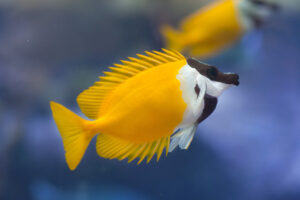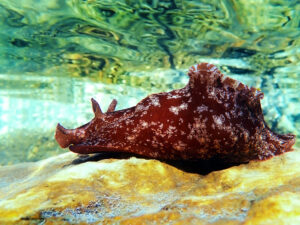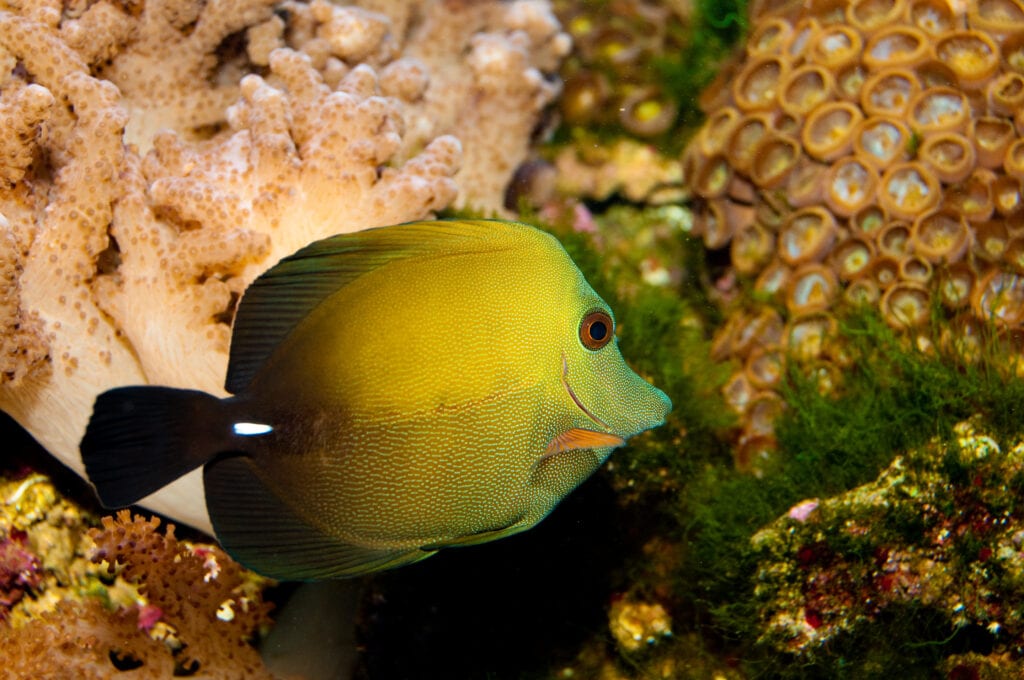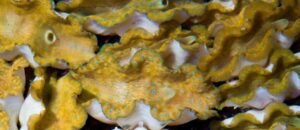When it comes to your clean-up crew in your saltwater aquarium, you usually will think of snails, crabs and starfish. However, there are some other cool inverts and fish you can add that can help tremendously with your aquarium algae clean-up.
There are so many saltwater fish that eat algae and this is just my list of my top 5. Most tangs will graze throughout the aquarium between meals looking for algae along with many other blennies. Dealing with algae in your aquarium can be very frustrating but it is necessary to take a few steps and process the best solution before jumping to conclusions. Ensure that the clean-up animal will get along with everything else in the tank and be a suitable fit. It’s easy for us hobbyists to panic and try to find an immediate solution, but always assess your situation before diving in!
Lawnmower blenny
 Starting at number one on my list of fish that eat algae is the lawnmower blenny. As you can tell from the name, these guys can really chow down on algae in the aquarium. They tend to be fairly shy and hang out in the rocks all day looking around for algae to graze. They can become aggressive towards other blennies which is something to keep in mind. Once they become comfortable in the aquarium you will notice their huge personalities will begin to show. Although they can be shy and easily frightened, they will eventually become one of the most animated fish in your tank. Once they have consumed most of the nuisance algae in the aquarium, it is a good idea to add some seaweed to their diet. They get around 4-6 inches and I would recommend a minimum of a 40 gallon aquarium for them. The Molly Miller blenny is a similar (and captive bred!) species that is known to consume aiptasia as well as algae.
Starting at number one on my list of fish that eat algae is the lawnmower blenny. As you can tell from the name, these guys can really chow down on algae in the aquarium. They tend to be fairly shy and hang out in the rocks all day looking around for algae to graze. They can become aggressive towards other blennies which is something to keep in mind. Once they become comfortable in the aquarium you will notice their huge personalities will begin to show. Although they can be shy and easily frightened, they will eventually become one of the most animated fish in your tank. Once they have consumed most of the nuisance algae in the aquarium, it is a good idea to add some seaweed to their diet. They get around 4-6 inches and I would recommend a minimum of a 40 gallon aquarium for them. The Molly Miller blenny is a similar (and captive bred!) species that is known to consume aiptasia as well as algae.
Scopas tangs
Scopas tangs are well known for doing a great job at picking at the rocks in your tank, eating any bit of algae they can find. If your aquarium is covered in algae, you may want to limit the amount of seaweed you offer in order to ensure that they will eat up as much as possible faster. However, if you start noticing that your tang isn’t picking on algae much, it is crucial to offer them more seaweed. Tangs can be known for having sunken bellies when not offered enough seaweed for their diet. Still, though they eat lots of algae, it is best to offer them an omnivorous diet as they also require meaty foods.
Scopas tangs should not be housed in groups or pairs as they tend to be very aggressive towards each other. These guys will get up to 12 inches in size and require a 75 gallon aquarium minimum.
Foxface rabbitfish
Foxface rabbitfish offers a stunning bright yellow color to your aquarium along with their habit of eating all of the algae they find, including most macroalgae. This fish makes a very docile addition to your tank. Much like the lawnmower blenny, foxfaces can be very shy and timid when first added to the aquarium. However, once they become comfortable, you will start to notice their dog-like personality. They quickly learn who offers them food and will swim towards you and even sometimes follow you around the tank as you look around.
One thing to keep in mind is that these guys are mildly venomous. You will notice that they have spikes on their dorsal and anal fins; these can offer a powerful sting. So, when you are working in your aquarium, it is important to keep an eye out for them. Luckily, their first instinct when frightened is usually to swim off and hide, but you still want to be cautious when keeping these fish in your aquarium!
This species requires a larger tank, as it is very active and can reach 8-10 inches in length.
Flame Angelfish
 Flame Angels offer a beautiful and vibrant cherry red color along with their love for grazing on your rocks for diatom and green film algae. These guys will reach around 4-6 inches in size and can be known to have an attitude. It is best to keep only one flame angel per tank due to their aggression towards their own kind. They can also show aggression towards other angels with similar shape and color. I would suggest a minimum of a 40 gallon aquarium and an omnivorous diet.
Flame Angels offer a beautiful and vibrant cherry red color along with their love for grazing on your rocks for diatom and green film algae. These guys will reach around 4-6 inches in size and can be known to have an attitude. It is best to keep only one flame angel per tank due to their aggression towards their own kind. They can also show aggression towards other angels with similar shape and color. I would suggest a minimum of a 40 gallon aquarium and an omnivorous diet.
Making sure you keep these guys well-fed with daily meals is essential for prime health along with helping to steer them away from nipping on coral. Most angels are known for nipping on coral occasionally due them always grazing on the live rock for algae in between meals.
Sea hares
These last animals are absolute BEASTS when it comes to eating algae in your aquarium. Sea hares are a brown/green slug that can clean an aquarium full of algae within days. They are perhaps not the most beautiful thing you will be adding to your aquarium but they definitely will work the hardest. Sea hares reach 12 inches long and are insatiable herbivorous grazers. Some local fish stores actually offer “Sea hare rentals” because of how quickly they will eat all of the algae in your aquarium. It is very easy for these guys to die of starvation once they “clean” a tank. When their job is finished, you need to offer them seaweed daily or pass them on to another aquarist.






Leave a Reply